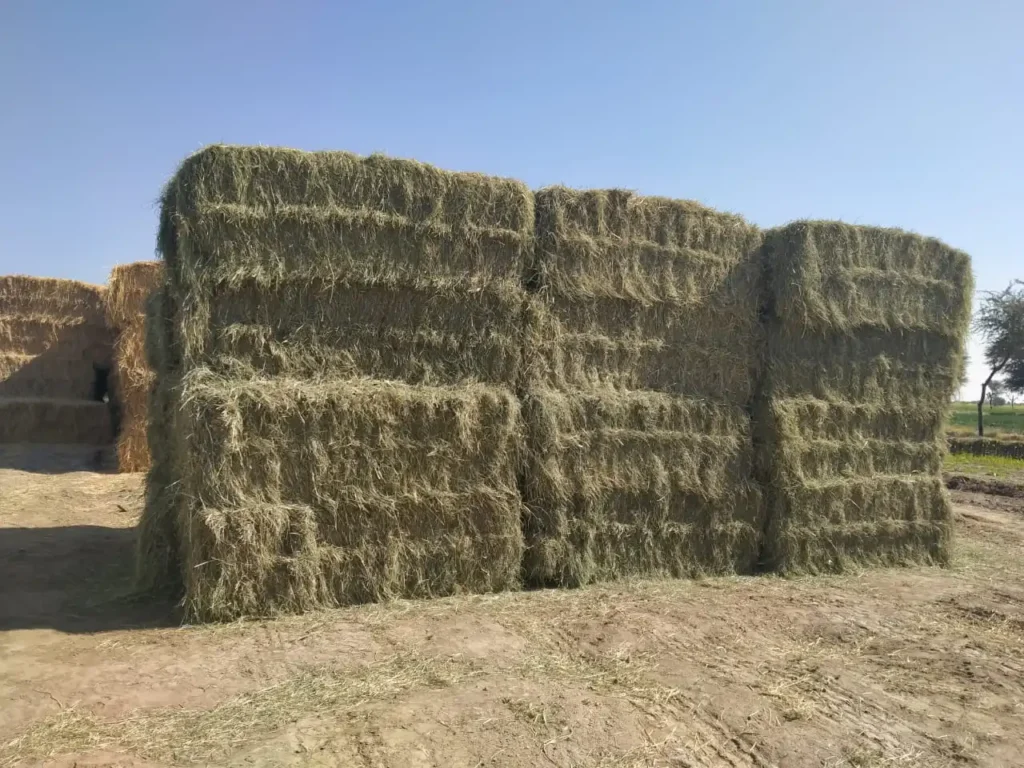Contact Us
+92 3000 116111Storage & Moisture Management of Rhodes Grass (Complete Guide)
High-quality fodder for dairy, beef, goats, sheep, camels & horses – ensuring better milk yield, healthy growth, and profitable farming.
- Finest Quality Guaranteed
- Global Shipping Coverage
- Certified & Tested Fodder
Rhodes grass (Chloris gayana) is used extensively for animal feed in Asia, the Middle East, and Africa due to its resilience to dry conditions, balanced nutrition, and palatability. However, storage and moisture control are other important factors in determining the actual value of Rhodes grass hay, in addition to harvest
If hay is harvested or stored with incorrect moisture levels, it can lose protein, energy, color, and even become unsafe for animals due to mold or heating. Proper storage and moisture control extend shelf life, maintain export standards, and ensure high returns for suppliers and farmers alike.
Everything you need to know about Rhodes grass hay storage best practices and moisture control is covered in this guide.

Rhodes Grass Hay Storage & Moisture Management Guide
1. Why Moisture Management is Critical
Moisture is the single most important factor determining hay quality:
- Too High Moisture (above 15%)
- Creates heat due to microbial activity.
- Causes mold growth and dusty hay.
- May lead to spontaneous combustion in storage sheds.
- Too Low Moisture (below 10%)
- Leaves become brittle and shatter during handling.
- Results in protein and nutrient loss.
- Ideal Moisture Levels:
- Small square bales → 12–15%
- Large round bales → 11–13%
- Export & long-term storage → 12–13%
2. Best Harvesting Practices for Storage
- Optimal Cutting Stage: Early-to-mid flowering for best protein (8–12%) and digestibility.
- Harvest Timing: Cut after dew dries and avoid rainfall.
- Field Handling: Spread evenly, avoid thick piles to ensure fast drying.
3. Curing & Drying Before Baling
- Drying Duration: 2–4 days (longer in humid weather).
- Turning Windrows: Turn 2–3 times daily for uniform drying.
- Moisture Testing: Use a hay moisture meter at multiple points.
4. Baling Recommendations
- Baling Moisture: Below 15% (12–13% for export).
- Bale Types: Small square → quick drying; Round → bulk storage.
- Density Control: Compact but not overly tight to prevent heating.
5. Storage Techniques for Rhodes Grass Hay
- Ground Preparation: Keep off soil using pallets or plastic sheets.
- Protection from Weather: Store under roof or cover with ventilated tarps.
- Ventilation: Leave gaps between bales and ensure air circulation.
- Stacking: Use pyramid or crisscross method, avoid overstacking.
6. Monitoring Stored Hay
- Moisture Checks: Monthly probe readings recommended.
- Heating Risks: Above 55°C → microbial growth; 70°C → fire risk.
- Mold & Dust: Musty smell, discoloration, or dust = unsafe for feed.
7. Shelf Life of Rhodes Grass
- Properly stored hay lasts 12–18 months.
- Protein and vitamins degrade over time — follow FIFO (feed oldest first).
8. Special Guidelines for Exporters
- Moisture: 12–14%
- Color: Bright green
- Aroma: Fresh, sweet smell
- Dust-Free: No mold or contamination
- Compression: High-density bales reduce shipping costs.
Tip: Invest in modern balers, humidity-controlled storage, and lab testing for protein & fiber.
Common Mistakes to Avoid
- Baling too early with high moisture → mold & fire risk.
- Storing directly on soil → absorbs moisture.
- Fully covering bales with plastic → traps humidity.
- Over-stacking → restricts airflow, increases heat.
- Ignoring rotation → nutrient loss in old hay.
Export Standards & Buyer Expectations
Our Rhodes Grass Hay is exported across the Middle East (UAE, Saudi Arabia, Qatar, Oman, Kuwait) meeting strict buyer expectations:
- Moisture: 12–14%
- Bright green color and fresh aroma
- Dust and mold-free
- Compressed, high-density bales for efficient shipping
BoviPak ensures top quality and consistency with every export shipment.
FAQs on Rhodes Grass Storage & Moisture
What is the best moisture level for Rhodes grass storage?
Maintain 12–13% for long-term storage and export; up to 15% for short-term feeding.
How can I prevent hay fires?
Ensure proper curing, monitor temperature, and keep ventilation open.
Can Rhodes grass hay be stored outside?
Yes, on raised pallets and covered with breathable tarpaulin.
How do I know if hay is spoiled?
Musty odor, discoloration, dust, or visible mold patches.
What is the maximum safe storage time?
Up to 18 months under ideal dry, ventilated storage.
🌾 Final Word
Maintaining the right moisture (12–13%) ensures Rhodes Grass Hay stays fresh, safe, and export-ready.
BoviPak guarantees properly cured, clean, and high-density bales meeting export standards across the UAE, Saudi Arabia, Oman, and Qatar.
Contact us today to secure premium-grade Rhodes Grass Hay for your dairy or livestock farm.
BoviPak – Rhodes Grass Hay Supplier
Address: Dubai Plaza Office #19, Main Multan Road, Muzaffar Garh, Punjab, Pakistan
Phone: +92 3000 116111
Email: info@bovipak.com
Lorem ipsum dolor sit amet consect etur adi pisicing elit sed.
Dubai Plaza Office #19 Main Multan road Muzaffar Garh, Punjab Pakistan
Newletter
Sign up now to get daily latest news & updates from us

